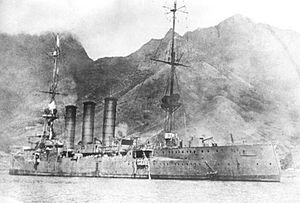Battle of Más a Tierra facts for kids
The Battle of Más a Tierra was a sea battle during World War I. It happened on March 14, 1915. The battle took place near the Chilean island of Más a Tierra. British ships fought against a German light cruiser. This battle was important because it destroyed the last ship of the German East Asia Squadron. The German ship, SMS Dresden, was trapped and then sunk by its own crew in Cumberland Bay.
Quick facts for kids Battle of Más a Tierra |
|||||||
|---|---|---|---|---|---|---|---|
| Part of the First World War | |||||||
 SMS Dresden shortly before sinking at Cumberland Bay. |
|||||||
|
|||||||
| Belligerents | |||||||
| Commanders and leaders | |||||||
| Strength | |||||||
| Armoured cruiser Kent Light cruiser Glasgow Auxiliary cruiser Orama |
Light cruiser Dresden | ||||||
| Casualties and losses | |||||||
| 15 wounded | 4 killed 14 wounded 315 interned Dresden scuttled |
||||||
Why the Battle Happened
After a big battle called the Battle of the Falkland Islands, the German ship SMS Dresden got away. It sailed into the Pacific Ocean. Its goal was to attack Allied merchant ships. These attacks didn't stop much shipping. But they did make the British navy use its ships to hunt Dresden.
By March 8, Dresden was low on supplies. It also needed repairs. Its captain, Lüdecke, decided to hide his ship. He planned to get coal in Cumberland Bay. This bay was near the neutral island of Más a Tierra. A neutral country is one that doesn't take sides in a war. If Dresden was found there, its crew could be held by the neutral country. This is called internment.
Hunting the Dresden
British naval forces were actively looking for the German cruiser. They had caught secret radio messages between German ships. The British had copies of German code books. But they also needed a "key" to read the messages. This key changed often.
A British signals officer, Charles Stewart, was very clever. He managed to decode a message from Dresden. The message said a coal ship should meet Dresden at Juan Fernandez on March 9.
A group of British ships set out. This group included the cruisers HMS Kent and Glasgow. It also had the auxiliary cruiser Orama. They found Dresden in the harbor. Its sailors were even playing a football match on the shore!
On March 14, the British ships trapped Dresden. This happened in neutral Chilean waters. They challenged the German ship to a fight.
The Battle Begins
The British ship Glasgow fired first at Dresden. The German ship was hit and caught fire. Dresden fired back for a short time. But its captain, Lüdecke, soon saw that the situation was hopeless. His ship was greatly outmatched and outnumbered. It was also stuck in the bay. Its coal bunkers were empty, and its engines were worn out.
Captain Lüdecke gave the order to abandon the ship. He also ordered his crew to sink it themselves. This is called scuttling. The German crew quickly left the cruiser in lifeboats. They headed for the safety of the island. The island was neutral territory.
The British cruisers kept firing at Dresden and the fleeing boats. The German light cruiser eventually exploded. It's not clear if the British firing caused the explosion. It might have been from charges set by the Germans to sink their own ship. After the explosion, the British commander ordered his ships to capture any survivors.
Three German sailors died during the battle. Fifteen were wounded. The British ships had no casualties.
What Happened Next
The sinking of Dresden meant the end of the German East Asian Squadron. All its other ships had already been sunk or interned. Only a few German merchant raiders were left in the Pacific Ocean. These included ships like SMS Seeadler and Wolf (1913).
The island of Más a Tierra belonged to Chile. Chile was a neutral country. Because of this, the German Consulate in Chile protested. They said the British had broken international law. They had attacked an enemy ship in neutral waters.
The wounded German sailors were taken to Valparaíso, Chile, for treatment. One of them later died from his injuries. The remaining 315 crew members of Dresden were held by Chile. They stayed there until the end of the war. After the war, those who didn't want to stay in Chile went back to Germany.
One of the crew members was Lieutenant Wilhelm Canaris. He later became a famous admiral and head of German intelligence. He escaped internment in August 1915. He was able to return to Germany in October 1915. There, he went back to active duty in the Imperial Navy.


